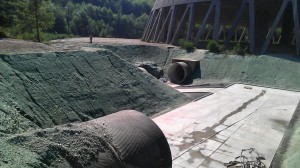
Submitted by Satsop Business Park

ELMA – Satsop Business Park has dug up some “buried treasure” that will likely help save lives. The “treasure” is a pair of enormous underground pipes that have now been transformed into a tunnel rescue training complex.
The week of Oct. 15, about 30 members of the Seattle Fire Department will be the first to use the 12-foot diameter pipes to conduct specialized tunnel safety and rescue training. The department has said it will use the new training center about 30 days a year. Observers from the New York Fire Department will also be attending.
“There is nowhere in the United States that has the potential for tunnel training as this place does with its 12-foot tunnels,” said Alan Vickery, assistant chief of the Seattle Fire Department. “These pipes are similar to the real world of tunneling work that is taking place in the Seattle area as well as internationally. Nothing that I’m aware of in the U.S. even compares,” he said.
Located 27 feet below the ground, the pair of parallel water pipes was intended to carry water to and from the nuclear power plants’ twin cooling towers. To create the training prop, one was dissected and the other was opened up to allow for three separate areas to set up various training scenarios. Digging out a portion of the pipe, dissecting the one pipe and installing needed safety systems cost Satsop Business Park about $200,000.
“To create a rescue training complex like this from scratch would cost millions of dollars,” said Tami Garrow, CEO of Satsop Business Park. (When the pipes were installed in 1979, the cost was $7 million.) “But at Satsop, we have this valuable infrastructure right beneath our feet that will benefit tunnel construction workers, repair crews, a wide range of rescue workers and the general public.
“Redeploying these pipes for training purposes makes all kinds of sense when you think about it – and like everything else at the Park, it is recycling at its most creative. It’s like uncovering a valuable resource that we know is already here, in this case, one that can help save lives and prevent injuries,” Garrow said
The Seattle Fire Department has been contracted to provide tunnel rescue service for the Sound Transit Light Rail System, Assistant Chief Vickery said. This new site will be set up to deliver more realistic training scenarios – and thus make it safer for tunnel workers and firefighters who are called to the scene of a tunnel emergency, he said.
Just a stone’s throw away from the recently completed tunnel rescue site, under the shadow of the operational cooling tower, is an outdoor tunnel construction training site being created by the Northwest Laborers-Employers Training Trust. That facility, complete with classrooms and a now-retired tunnel boring machine, nicknamed “Helene,” was created to teach tunnel workers how to safely operate in tunnels.
“Having this tunnel training rescue site at the Park dovetails nicely with what we’re doing to create a national tunnel training complex, said Mike Warren, the training director of the Northwest Laborers-Employers Training Trust. “I can see fire departments from across the U.S. and Canada coming to Satsop to train. It will be a very unique set up. Tunnel rescue training will be provided to union laborers as well.” The Laborers-Employers Training Trust also plans to use the tunnels for about 30 days a year, he said.
In addition to the Seattle Fire Department and Laborers-Employers Training Trust, there is growing interest by many other fire departments and safety organizations exploring the use of the tunnel rescue complex, said Nathan Hoover, project coordinator.
“A lot of organizations go to West Virginia to get rescue training. We can save those on the West Coast a lot of money in travel expenses alone,” said Hoover. “We’re expecting that the Army, which already does lots of training here, will be interested in the tunnels. In addition, we can see easily adding some structures in the future to create scenarios for high-angle rescue training someday.”
“I think this is a great opportunity for Satsop Business Park,” said Steve Poler, Chairman of the Board. “Anytime we can add a world-class training site to the Park it’s great, and to have something like this that is so different, where you can do things you can’t do anywhere else in the country is very exciting,” Poler said.
Satsop Business Park is a 1,700-acre mixed-use business and technology park located in scenic Grays Harbor County in Southwest Washington just 30 minutes from Olympia and the I-5 corridor. It is home to more than 30 businesses, offers 440 acres of developed, pad-ready land and buildings supported by super-sized infrastructure and surrounded by 1,200 acres of sustainable managed forestland.
The Park is managed by the Grays Harbor Public Development Authority, a public corporation whose mission is to create new jobs and investment for the region. More information on Satsop Business Park can be found at www.Satsop.com.
















































